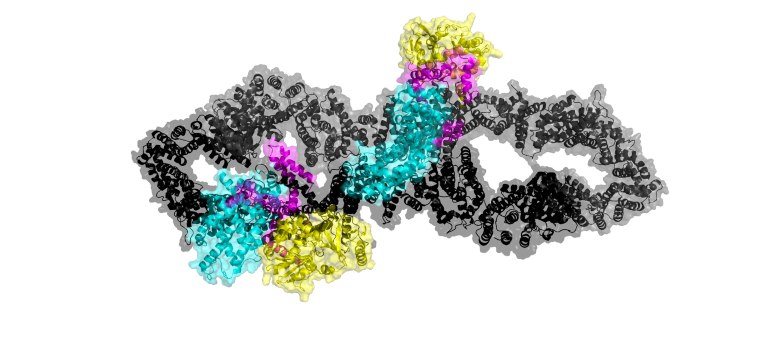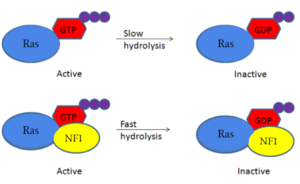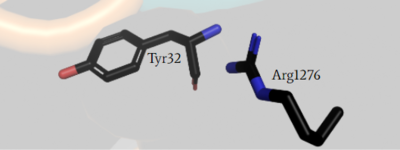Sandbox Reserved 1706
From Proteopedia
(Difference between revisions)
| Line 10: | Line 10: | ||
[https://en.wikipedia.org/wiki/Neurofibromatosis_type_I Neurofibromatosis Type 1] is a genetic disorder caused by mutations in the tumor suppressor gene NF1 that codes for the [https://en.wikipedia.org/wiki/GTPase-activating_protein GTPase-activating protein] neurofibromin. Neurofibromin is closely involved in signaling pathways such as [https://en.wikipedia.org/wiki/MAPK/ERK_pathway MARP/ERK], [https://en.wikipedia.org/wiki/PI3K/AKT/mTOR_pathway P13K/AKT/mTOR], and other cell signaling pathways that use [https://en.wikipedia.org/wiki/Ras_GTPase Ras] <ref name="Bergoug"> DOI:10.3390/cells9112365</ref>. Mutations that cause a decrease in activity of neurofibromin cause tumors to grow along your nerves. As neurofibromin is ubiquitously expressed throughout the body, these tumors can grow anywhere. Neurofibromin is located in the [https://en.wikipedia.org/wiki/Cytosol cytosol] of the cell but is recruited to the [https://en.wikipedia.org/wiki/Cell_membrane plasma membrane] to bind to [https://en.wikipedia.org/wiki/Ras_GTPase Ras]. The structure of neurofibromin was detemed through high-resolution single particles [https://en.wikipedia.org/wiki/Cryogenic_electron_microscopy cryogenic electron microscopy] to understand the overall structure and the different domains. [https://en.wikipedia.org/wiki/X-ray_crystallography#:~:text=X%2Dray%20crystallography%20is%20the,diffract%20into%20many%20specific%20directions. X-Ray crystallography] experiments found inconsistency in the structural determination.<ref name="Bergoug"> DOI:10.3390/cells9112365</ref><ref name="Bourne"> DOI:10.1038/39470</ref><ref name="Lupton"> DOI:10.1038/s41594-021-00687-2</ref><ref name="Naschberger"> DOI:10.1038/s41586-021-04024-x</ref> | [https://en.wikipedia.org/wiki/Neurofibromatosis_type_I Neurofibromatosis Type 1] is a genetic disorder caused by mutations in the tumor suppressor gene NF1 that codes for the [https://en.wikipedia.org/wiki/GTPase-activating_protein GTPase-activating protein] neurofibromin. Neurofibromin is closely involved in signaling pathways such as [https://en.wikipedia.org/wiki/MAPK/ERK_pathway MARP/ERK], [https://en.wikipedia.org/wiki/PI3K/AKT/mTOR_pathway P13K/AKT/mTOR], and other cell signaling pathways that use [https://en.wikipedia.org/wiki/Ras_GTPase Ras] <ref name="Bergoug"> DOI:10.3390/cells9112365</ref>. Mutations that cause a decrease in activity of neurofibromin cause tumors to grow along your nerves. As neurofibromin is ubiquitously expressed throughout the body, these tumors can grow anywhere. Neurofibromin is located in the [https://en.wikipedia.org/wiki/Cytosol cytosol] of the cell but is recruited to the [https://en.wikipedia.org/wiki/Cell_membrane plasma membrane] to bind to [https://en.wikipedia.org/wiki/Ras_GTPase Ras]. The structure of neurofibromin was detemed through high-resolution single particles [https://en.wikipedia.org/wiki/Cryogenic_electron_microscopy cryogenic electron microscopy] to understand the overall structure and the different domains. [https://en.wikipedia.org/wiki/X-ray_crystallography#:~:text=X%2Dray%20crystallography%20is%20the,diffract%20into%20many%20specific%20directions. X-Ray crystallography] experiments found inconsistency in the structural determination.<ref name="Bergoug"> DOI:10.3390/cells9112365</ref><ref name="Bourne"> DOI:10.1038/39470</ref><ref name="Lupton"> DOI:10.1038/s41594-021-00687-2</ref><ref name="Naschberger"> DOI:10.1038/s41586-021-04024-x</ref> | ||
==Function== | ==Function== | ||
| - | Neurofibromin is a [https://en.wikipedia.org/wiki/GTPase-activating_protein GTPase-activating protein] that binds to [https://en.wikipedia.org/wiki/Ras_GTPase Ras], a [https://en.wikipedia.org/wiki/GTPase GTPase], to increase the hydrolysis of GTP to GDP. This inactivates the cell signaling of Ras until another [https://en.wikipedia.org/wiki/Guanosine_triphosphate GTP] can replace the [https://en.wikipedia.org/wiki/Guanosine_diphosphate GDP] from the cytosol. Neurofibromin and Ras binding is possible in only the <scene name='90/904311/Open_conformation/2'>open conformation</scene> of Neurofibromin. The mechanism is shown in figure 1 and displays the slow hydrolysis of GTP bound to Ras and the fast hydrolysis of GTP when bound to Neurofibromin. <ref name="Bourne"> DOI:10.1038/39470</ref><ref name="Lupton"> DOI:10.1038/s41594-021-00687-2</ref><ref name="Naschberger"> DOI:10.1038/s41586-021-04024-x</ref> [[Image:RasNeurofibrominMech.PNG|300px|left|thumb|Figure 1: Simple diagram of Ras GTP hydrolysis when bound to | + | Neurofibromin is a [https://en.wikipedia.org/wiki/GTPase-activating_protein GTPase-activating protein] that binds to [https://en.wikipedia.org/wiki/Ras_GTPase Ras], a [https://en.wikipedia.org/wiki/GTPase GTPase], to increase the hydrolysis of GTP to GDP. This inactivates the cell signaling of Ras until another [https://en.wikipedia.org/wiki/Guanosine_triphosphate GTP] can replace the [https://en.wikipedia.org/wiki/Guanosine_diphosphate GDP] from the cytosol. Neurofibromin and Ras binding is possible in only the <scene name='90/904311/Open_conformation/2'>open conformation</scene> of Neurofibromin. The mechanism is shown in figure 1 and displays the slow hydrolysis of GTP bound to Ras and the fast hydrolysis of GTP when bound to Neurofibromin. <ref name="Bourne"> DOI:10.1038/39470</ref><ref name="Lupton"> DOI:10.1038/s41594-021-00687-2</ref><ref name="Naschberger"> DOI:10.1038/s41586-021-04024-x</ref> [[Image:RasNeurofibrominMech.PNG|300px|left|thumb|Figure 1: Simple diagram of Ras GTP hydrolysis when bound to neurofibromin and unbound. The speed of GTP hydrolysis is significantly increased when bound to neurofibromin. Ras is inactive when bound to GDP and active when bound to GTP ]] |
==Structure== | ==Structure== | ||
| + | ===Domains=== | ||
| + | [[Image:Domain.PNG|500px|right|thumb|Figure 2: Domains for NF1 and the pertinent colors. Numerical values show domain locations along the polypeptide chain.]] | ||
| + | ====N-C HEAT ARM==== | ||
| + | Neurofibromin in its closed and open conformations holds five separate domains. The first domain shown in black is representative of two separate but very similar domains, the N-HEAT ARM(N-Terminal) and C-HEAT ARM(C-Terminal). Structurally the N-HEAT Arm’s consists of various helices and loops that interconnect on one of the existing protomers. The N-HEAT ARM is critical in stabilization and linking the other domains which extend out from the core and are important to its catalytic function. The N-HEAT ARM in its linkage with the GRD catalytic domain, has a direct impact on the relative conformational change from the active (Ras BOUND) to inactive (Ras unbound) states. Finally, the Zn2+ binding site also exists downstream on the N-HEAT ARM just before the GRD and SEC14-PH domains. The C-HEAT Arm is linked structurally to the N-HEAT ARM and is a continuation of the protomer. It extends out on the opposing end from the other domains. In its structure consisting of various loops and helices, it is involved with stabilization and linking to the GRD and SEC14-PH and plays a role in the conformational changes from the closed to open state.<ref name="Lupton"> DOI:10.1038/s41594-021-00687-2</ref><ref name="Naschberger"> DOI:10.1038/s41586-021-04024-x</ref> | ||
| + | ====GRD==== | ||
| + | Neurofibromin’s main catalytic domain is the GRD active site. Linked structurally to both HEAT ARM’s, it consists of mainly loops and helices. Per protomer, there is one single GRD binding site. In the closed state Ras cannot bind due to a steric hindrance in which Ras clashes with the N-HEAT ARM upon attempting to bind to the GRD site. In its active state GRD can bind Ras. The critical residue within the GRD site is Arg1276.<ref name="Lupton"> DOI:10.1038/s41594-021-00687-2</ref><ref name="Naschberger"> DOI:10.1038/s41586-021-04024-x</ref> | ||
| + | ====GAPex==== | ||
| + | The GAPex subdomain of the GRD site lies between the Sec14-PH and GRD catalytic sites. This domain is non-catalytic and structurally consists of various loops and helices. Its main function is to bind SPRED-1, which is a recruiter protein that binds to this subdomain in the cytosol to recruit Neurofibromin to the plasma membrane. <ref name="Lupton"> DOI:10.1038/s41594-021-00687-2</ref><ref name="Naschberger"> DOI:10.1038/s41586-021-04024-x</ref> | ||
| + | ====Sec14-PH==== | ||
| + | The Sec14-PH domain is linked and extends out from the HEAT ARM’s and consists of largely various helices and loops. Its function is a membrane associated domain and holds a largely hydrophobic cavity allowing for binding to the plasma membrane. In the <scene name='90/904311/Closed_conformation/3'>closed conformation</scene> it is blocked by the GRD and is inaccessible to the lipid membrane. In the <scene name='90/904311/Open_conformation/2'>open conformation</scene> it becomes exposed and can access the lipid membrane for interaction.<ref name="Lupton"> DOI:10.1038/s41594-021-00687-2</ref><ref name="Naschberger"> DOI:10.1038/s41586-021-04024-x</ref> | ||
| + | ===Conformations=== | ||
Neurofibromin is a [https://en.wikipedia.org/wiki/Protein_dimer protein dimer] that exists in the<scene name='90/904311/Closed_conformation/3'>closed</scene> and <scene name='90/904311/Open_conformation/2'>open</scene> conformation. Each [https://en.wikipedia.org/wiki/Protomer protomer] contains a GRD, Sec14-PH, and a GAPex domain located on a HEAT N-C arm. Ras binds to the GRD site with Arg1276 being the critical residue for binding. <ref name="Bourne"> DOI:10.1038/39470</ref><ref name="Lupton"> DOI:10.1038/s41594-021-00687-2</ref><ref name="Naschberger"> DOI:10.1038/s41586-021-04024-x</ref> | Neurofibromin is a [https://en.wikipedia.org/wiki/Protein_dimer protein dimer] that exists in the<scene name='90/904311/Closed_conformation/3'>closed</scene> and <scene name='90/904311/Open_conformation/2'>open</scene> conformation. Each [https://en.wikipedia.org/wiki/Protomer protomer] contains a GRD, Sec14-PH, and a GAPex domain located on a HEAT N-C arm. Ras binds to the GRD site with Arg1276 being the critical residue for binding. <ref name="Bourne"> DOI:10.1038/39470</ref><ref name="Lupton"> DOI:10.1038/s41594-021-00687-2</ref><ref name="Naschberger"> DOI:10.1038/s41586-021-04024-x</ref> | ||
| - | ===Closed conformation=== | + | ====Closed conformation==== |
| - | Ras is unable to bind to the GRD active site when both of the | + | Ras is unable to bind to the GRD active site when both of the neurofibromin protomers are in the closed conformation. In the<scene name='90/904311/Closed_conformation/3'>closed conformation</scene>, one protomer has its domains shifted by a 130 degree rotation of three separate linkers. That rotation places <scene name='90/904311/Closed_arg/4'>Arg1276 in the closed conformation</scene> in an orientation that <scene name='90/904312/Closed_zoom/1'>sterically hinders the binding between Ras and Arg1276</scene> in the GRD site (Figure 3). Also in this depiction Ras binding to the GRD site is inhibited by the N-HEAT ARM as it interferes at the GRD in Ras attempting to bind to the active site and is sterically hindered. Making <scene name='90/904311/Closed_with_ras/2'>Ras binding in closed conformation</scene> sterically impossible in the <scene name='90/904311/Closed_conformation/3'>closed conformation</scene> |
. The <scene name='90/904311/Closed_conformation/3'>closed conformation</scene> can exist naturally without any form of stabilization but will also fall back to the <scene name='90/904311/Open_conformation/2'>open conformation</scene>.<ref name="Bourne"> DOI:10.1038/39470</ref> <ref name="Lupton"> DOI:10.1038/s41594-021-00687-2</ref><ref name="Naschberger"> DOI:10.1038/s41586-021-04024-x</ref> | . The <scene name='90/904311/Closed_conformation/3'>closed conformation</scene> can exist naturally without any form of stabilization but will also fall back to the <scene name='90/904311/Open_conformation/2'>open conformation</scene>.<ref name="Bourne"> DOI:10.1038/39470</ref> <ref name="Lupton"> DOI:10.1038/s41594-021-00687-2</ref><ref name="Naschberger"> DOI:10.1038/s41586-021-04024-x</ref> | ||
| - | ====Zinc Stabilized==== | + | =====Zinc Stabilized===== |
The <scene name='90/904311/Closed_conformation/3'>closed conformation</scene> of Neurofibromin can be stabilized by a zinc ion to prevent the shift back to an <scene name='90/904311/Open_conformation/2'>open conformation</scene>. This binding is done between <scene name='90/904311/Zinc_binding_site/5'>Cys1032, His1558, His1576, and Zinc</scene>. Cys1032 is within the N-HEAT domain and both His1558 and His1576 are within the GAPex-subdomain. When zinc stabilizes Neurofibromin, it will stay in the <scene name='90/904311/Closed_conformation/3'>closed conformation</scene> and continue to inhibit the binding of RAS.<ref name="Bourne"> DOI:10.1038/39470</ref><ref name="Lupton"> DOI:10.1038/s41594-021-00687-2</ref><ref name="Naschberger"> DOI:10.1038/s41586-021-04024-x</ref> | The <scene name='90/904311/Closed_conformation/3'>closed conformation</scene> of Neurofibromin can be stabilized by a zinc ion to prevent the shift back to an <scene name='90/904311/Open_conformation/2'>open conformation</scene>. This binding is done between <scene name='90/904311/Zinc_binding_site/5'>Cys1032, His1558, His1576, and Zinc</scene>. Cys1032 is within the N-HEAT domain and both His1558 and His1576 are within the GAPex-subdomain. When zinc stabilizes Neurofibromin, it will stay in the <scene name='90/904311/Closed_conformation/3'>closed conformation</scene> and continue to inhibit the binding of RAS.<ref name="Bourne"> DOI:10.1038/39470</ref><ref name="Lupton"> DOI:10.1038/s41594-021-00687-2</ref><ref name="Naschberger"> DOI:10.1038/s41586-021-04024-x</ref> | ||
| - | ===Open conformation=== | + | ====Open conformation==== |
| - | In the open state, one of the protomers remains in the closed | + | In the open state, one of the protomers remains in the closed conformation inaccessible to Ras, while the other protomer is conformationally changed into the open form with Ras bound. |
In the <scene name='90/904311/Open_conformation/2'>open conformation</scene> the one protomer is shifted due to a 90 rotation. This rotation allows for binding between RAS and the <scene name='90/904311/Arg_1276_open/1'>Arg1276</scene> | In the <scene name='90/904311/Open_conformation/2'>open conformation</scene> the one protomer is shifted due to a 90 rotation. This rotation allows for binding between RAS and the <scene name='90/904311/Arg_1276_open/1'>Arg1276</scene> | ||
| - | in the GRD site while in the <scene name='90/904311/Open_conformation/2'>open conformation</scene>. Allowing for the <scene name='90/904312/Arg_1276_open/11'>Arg1276 interaction with Ras in the open conformation</scene> to occur without any steric hindrance as shown in the <scene name='90/904311/Closed_conformation/3'>closed conformation</scene>. In the open state, one of the protomers remains in the closed | + | in the GRD site while in the <scene name='90/904311/Open_conformation/2'>open conformation</scene>. Allowing for the <scene name='90/904312/Arg_1276_open/11'>Arg1276 interaction with Ras in the open conformation</scene> to occur without any steric hindrance as shown in the <scene name='90/904311/Closed_conformation/3'>closed conformation</scene>. In the open state, one of the protomers remains in the closed conformation inaccessible to Ras, while the other protomer is conformationally changed into the open form with Ras bound. It is important to mention, the GRD and Sec14-PH are reoriented away from one another and the GRD site is no longer sterically hindered and clashing with the N-HEAT ARM and is completely accessible for Ras to bind. To undergo the movement to the open conformation, significant conformational changes exist within three separate linkers (L1, L2, L3).<ref name="Bourne"> DOI:10.1038/39470</ref> <ref name="Lupton"> DOI:10.1038/s41594-021-00687-2</ref><ref name="Naschberger"> DOI:10.1038/s41586-021-04024-x</ref> |
| - | ===Conformational Change Linkers=== | + | ====Conformational Change Linkers==== |
The rotation of the domains between the <scene name='90/904311/Open_conformation/2'>open conformation</scene> and <scene name='90/904311/Closed_conformation/3'>closed conformation</scene> of Neurofibromin are conducted by three helical linkers named L1, L2, and L3. The <scene name='90/904311/Linker_closed/1'>linkers in the closed conformation</scene> | The rotation of the domains between the <scene name='90/904311/Open_conformation/2'>open conformation</scene> and <scene name='90/904311/Closed_conformation/3'>closed conformation</scene> of Neurofibromin are conducted by three helical linkers named L1, L2, and L3. The <scene name='90/904311/Linker_closed/1'>linkers in the closed conformation</scene> | ||
<scene name='90/904312/Linker_closed/2'>(zoomed in)'</scene> and the <scene name='90/904311/Linkers_open/1'>linkers in the open conformation</scene> | <scene name='90/904312/Linker_closed/2'>(zoomed in)'</scene> and the <scene name='90/904311/Linkers_open/1'>linkers in the open conformation</scene> | ||
| Line 28: | Line 39: | ||
<scene name='90/904312/Linker_closed/2'>(zoomed in)'</scene> and <scene name='90/904311/Linkers_open/1'>open conformation</scene> | <scene name='90/904312/Linker_closed/2'>(zoomed in)'</scene> and <scene name='90/904311/Linkers_open/1'>open conformation</scene> | ||
<scene name='90/904312/Zoomed_lo/1'>(zoomed in)'</scene>.<ref name="Lupton"> DOI:10.1038/s41594-021-00687-2</ref><ref name="Naschberger"> DOI:10.1038/s41586-021-04024-x</ref> | <scene name='90/904312/Zoomed_lo/1'>(zoomed in)'</scene>.<ref name="Lupton"> DOI:10.1038/s41594-021-00687-2</ref><ref name="Naschberger"> DOI:10.1038/s41586-021-04024-x</ref> | ||
| - | == | + | ==Ras Binding== |
| - | + | ||
| - | + | ||
| - | + | ||
| - | + | ||
| - | + | ||
| - | + | ||
| - | + | ||
| - | + | ||
| - | + | ||
| - | + | ||
Arg1276 is the critical residue within the GRD site needed for proper binding to Ras. The interaction between <scene name='90/904311/Arg_1276_open/1'>Arg1276 and Ras in the open conformation</scene> | Arg1276 is the critical residue within the GRD site needed for proper binding to Ras. The interaction between <scene name='90/904311/Arg_1276_open/1'>Arg1276 and Ras in the open conformation</scene> | ||
| - | <scene name='90/904312/Arg_1276_open/11'>(zoomed in)</scene> is only possible in the open | + | <scene name='90/904312/Arg_1276_open/11'>(zoomed in)</scene> is only possible in the open conformation (Figure 4). In the open conformation, the arginine finger binds to the backbone γ-carbon of Y32 to assist in eventual hydrolysis of GTP. In the closed conformation this was inhibited by E31 but in the open conformation the conformational change allows for an interaction of R1276 and the γ-carbon so they align with one another. This allows for the normal function of neurofibromin in the rapid rate increase of GTP hydrolysis upon Ras binding. |
<scene name='90/904311/Closed_arg/4'>Arg1276 in closed conformation </scene> | <scene name='90/904311/Closed_arg/4'>Arg1276 in closed conformation </scene> | ||
| - | <scene name='90/904312/Closed_zoom/1'>(zoomed in)</scene> has steric clashing with Ras making binding of Ras impossible (Figure 3). In the closed | + | <scene name='90/904312/Closed_zoom/1'>(zoomed in)</scene> has steric clashing with Ras making binding of Ras impossible (Figure 3). In the closed conformation the Arginine finger attempts to bind the backbone gamma carbon(RAS) of a Tyrosine residue(Y32) to assist in hydrolysis, but instead clashes with a Glutamate residue(E31) that would otherwise not interfere in the open conformation and can no longer bind properly. This residue impacts binding of Ras and is of critical importance in determining if Ras is able to bind to the GRD site or not to assist in eventual hydrolysis of GTP. |
| - | Mutations to the arginine finger are shown to slow function of | + | Mutations to the arginine finger are shown to slow the function of neurofibromin and other GTPases in their function in accelerating GTP hydrolysis. When a Ras GAP such as neurofibromin can functionally utilize its arginine finger, it allows neurofibromin to rapidly hydrolyze GTP when bound to Ras. This emphasizes the importance of the R1276 residue for the GRD site binding to Ras.<ref name="Bourne"> DOI:10.1038/39470</ref><ref name="Lupton"> DOI:10.1038/s41594-021-00687-2</ref><ref name="Naschberger"> DOI:10.1038/s41586-021-04024-x</ref> |
[[Image:ClosedArgFinger.PNG|400px|left|thumb| Figure 3: Arg1276 of the GRD active site is sterically hindered in the closed conformation by Glu31 of Ras as it attempts to interact with the γ-carbon of Tyr32, but is unable to properly form a bond. Making binding to Ras impossible in the closed conformation. ]] [[Image:OpenArgFinger.PNG|400px|none|thumb|Figure 4: Arg1276 of the GRD active site is no longer sterically hindered in the open conformation by Glu31 of Ras, making it able to interact with γ-carbon of Tyr32 and form a bond with Ras. ]] | [[Image:ClosedArgFinger.PNG|400px|left|thumb| Figure 3: Arg1276 of the GRD active site is sterically hindered in the closed conformation by Glu31 of Ras as it attempts to interact with the γ-carbon of Tyr32, but is unable to properly form a bond. Making binding to Ras impossible in the closed conformation. ]] [[Image:OpenArgFinger.PNG|400px|none|thumb|Figure 4: Arg1276 of the GRD active site is no longer sterically hindered in the open conformation by Glu31 of Ras, making it able to interact with γ-carbon of Tyr32 and form a bond with Ras. ]] | ||
==SPRED 1== | ==SPRED 1== | ||
Revision as of 13:14, 12 April 2022
| This Sandbox is Reserved from February 28 through September 1, 2022 for use in the course CH462 Biochemistry II taught by R. Jeremy Johnson at the Butler University, Indianapolis, USA. This reservation includes Sandbox Reserved 1700 through Sandbox Reserved 1729. |
To get started:
More help: Help:Editing |
Neurofibromin 1
| |||||||||||





